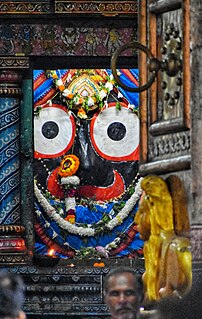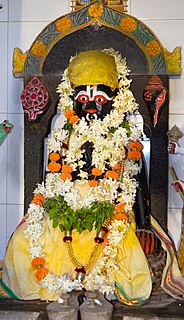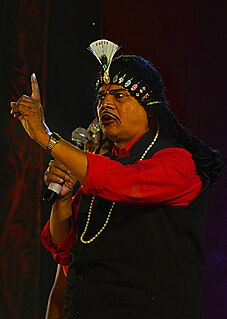
Odia is an Indo-Aryan language spoken in the Indian state of Odisha. It is the official language in Odisha where native speakers make up 82% of the population, and it is also spoken in parts of West Bengal, Jharkhand and Chhattisgarh. Odia is one of the many official languages of India; it is the official language of Odisha and the second official language of Jharkhand. The language is also spoken by a sizeable population of at least 1 million people in Chhattisgarh.

Jagannath is a deity worshipped in regional Hindu traditions in India and Bangladesh as part of a triad along with his brother Balabhadra and sister, devi Subhadra. Jagannath within Odia Hinduism is the supreme god, Purushottama, Para Brahman. To most Vaishnava Hindus, particularly the Krishnaites, Jagannath is an abstract representation of Krishna, or Vishnu, sometimes as the avatar of Krishna or Vishnu. To some Shaiva and Shakta Hindus, he is a symmetry-filled tantric form of Bhairava, a fierce manifestation of Shiva associated with annihilation.
Das is a common last name in South Asia, among adherents of Hinduism and Sikhism, as well as those who converted to Islam or Christianity. It is a derived from the Sanskrit word Dasa meaning servant, "devotee," or "votary". "Das" may be inferred to be one who has surrendered to God.
The Odia (ଓଡ଼ିଆ), formerly spelled Oriya, are native to the Indian state of Odisha and have the Odia language as their mother tongue. They constitute a majority in the eastern coastal state of Odisha, with significant minority populations in Andhra Pradesh, Chhattisgarh, Jharkhand and West Bengal.

Sarala Dasa was a 15th-century poet and scholar of Odia literature. Best known for three Odia books — Mahabharata, Vilanka Ramayana and Chandi Purana — he was the first scholar to write in Odia. As an originator of Odia literature, his work has formed an enduring source of information for succeeding generations.

Gopala Dasa (1721–1769) was a prominent 18th-century Kannada language poet and saint belonging to the Haridasa tradition. With other contemporary Haridasas such as Vijaya Dasa and Jagannatha Dasa, Gopala Dasa propagated the Dvaita philosophy of Madhvacharya in South India through Kirtans known as Dasara Padagalu with the pen-name "Gopala Vittala".He is Ganesa Amsha.
Odia literature is literature written in the Odia language, mostly from the Indian state of Odisha. The modern Odia language is mostly formed from Tadbhava words with significant Sanskrit (Tatsama) influences, along with loanwoards from Desaja, English, Hindustani (Hindi/Urdu), Persian, and Arabic. Its earliest written texts date from around 1000 CE. The earliest Odia newspaper was Utkala Deepika, first published on August 4, 1866.

MahapurusaAchyutananda Dasa (Odia:-ଅଚ୍ୟୁତାନନ୍ଦ ଦାସ ) was a 16th-century poet seer and Vaishnava saint from Odisha, India. He was popularly known as Gopala Guru. He was considered to have the power to see the past, present and future. He was a prolific author, and one of the group of five, that led a revolution in spirituality in Odisha by translating Sanskrit texts into the Odia language for common people.
Odisha is one of the 28 states of India, located in the eastern coast. It is surrounded by the states of West Bengal to the north-east, Jharkhand to the north, Chhattisgarh to the west and north-west, Andhra Pradesh to the south and south-west. Odia is the official and most widely spoken language, spoken by 33.2 million according to the 2001 Census. The modern state of Odisha was established on 1 April 1936, as a province in British India, and consisted predominantly of Odia-speaking regions. April 1 is celebrated as Odisha Day.

Jagannatha Dasa (1728–1809), a native of Manvi town in the Raichur district, Karnataka state, India,is a disciple of Madhvacharya and is considered one of the notable Haridasa of Dvaita Vedanta of Madhva saint-poets of the Kannada language. Apart from authoring numerous well-known devotional songs that propagate the Vaishnava bhakti ("faith") of Dvaita Vedanta of Madhvacharya, Jagannatha Dasa wrote the Harikathamritasara in the native shatpadi metre and Tattva suvali in the native tripadi metre. He was also an accomplished scholar in the Sanskrit language.

Odissi music is a genre of classical music in India, originated from the eastern state of Odisha. The traditional ritual music for the service of Lord Jagannatha, Odissi music has a history spanning over two thousand years, authentic sangita-shastras or treatises, unique Ragas & Talas and a distinctive style of rendition.
Dinakrushna Das (1650–1710) was a poet of Odisha, India, belonging to the Vaishnava tradition of bhakti movement. He is known for his Odia poem titled "Rasakallola", which is devoted to Lord Krishna. Among his many literary compositions, "Artatrana Chautisa" is a reputed one. Dinakrusna's Rasakallola and his standalone compositions including "chaupadi", "prabhati", "janana", "chautisa", "bhajana", and "malasri" are central to the repertoire of Odissi music, the traditional classical music of the state.

AtibadiJagannatha Dasa was an Odia poet and litterateur. He was one of the 5 great poets in Odia literature, the Panchasakha. He wrote the Odia Bhagabata.

Banamali Dasa is an Indian medieval Odia bhakta-poet & composer of Odissi music from the state of Odisha. "Dinabandhu daitari", "Kede chanda jane lo sahi" and "Manima he etiki maguni mora" are some of his notable writings that are used in Odissi. His songs are popularly sung in festivals, public gatherings and in Odissi dance. Banamali's compositions are set to traditional Odissi ragas and talas & are extremely popular in the Odissi music repertoire. He is considered as the foremost poet of the medieval Odia bhakti-literature Started with writing rustic devotional Poetry, he later began to compose "bhakti"-poetry which gained larger acceptance and popularity among the other contemporary poets of his time. Typically, his poems are eyewitness accounts, and their simple, fervent language is much appreciated.

Kalpanakumari Devi was an Indian novelist and poet in the Odia language. She won the 2011 Sahitya Akademi Award for Odia literature.
Jagamohana Ramayana also known as Dandi Ramayana popularly across Odisha is an epic poem composed by the 15th-century poet Balarama Dasa. This work is a retelling of the Ramayana though not a direct translation.

Prataparudra Deva was the third Gajapati emperor of Odisha from the Suryavamsa Gajapati Empire started by his grandfather Kapilendra Deva Routaraya. He ruled from the year 1497 to 1540 A.D. Besides being a ruler, he was a devout Vaishnava and adherent of the famous saint, Sri Chaitanaya who arrived in Odisha during his rule. His life was extremely occupied with overwhelming military campaigns in defense of his inherited territory from three frontal invasions by the enemy states Vijayanagar, Hussain Shahi dynasty of Bengal and Qutb Shahi dynasty of Golconda. He lost large portions of his territory to the neighboring enemy states initiating the dissolution of Odisha's military hegemony and imperial status that continued for nearly a period of 600 years before him.

Bharata Lila is an Indian performing theater form of Ganjam district of Odisha. The plot is based on characters of the Mahabharata, thus the name of the form. Because of the importance of a central character Duari, Arjuna's sentry, it is also called Duari Nata or Duari Llla. The focal point of the plot is the story of Arjuna & Subhadra's romance, which is why it is also known as Subhadra Harana. Apart from Ganjam, it is also performed in some parts in western Odisha. The play is known for its effective use of humour within the traditional storyline. A regular performance of Bharata Lila in the 21st century goes on for about 10–12 hours. In the last century performances used to last for a couple of days at a stretch. The badi is a performance method in Odisha's traditional artforms where opponents compete with each other. In urban settings, Bharata Lila performances are regularly condensed to just 2–3 hours owing to lack of time.

Balarama Dasa was an Odia poet and litterateur. He was one of the 5 great poets in Odia literature, the Panchasakha during the Bhakti age of literature. He was the eldest of the Pancha sakha. He wrote the Jagamohana Ramayana also known as Dandi Ramayana.

Desaraja AdiguruSinghari Shyamasundar Kar was a renowned Odissi musician, Guru, singer, scholar and composer. Born to a sebayata (servitor) family of the Jagannatha Temple, he was groomed under veteran masters of the temple tradition and soon rose to be one of the towering Gurus of Odissi classical music in the 20th century. He was most known for his powerful voice and intricate style, his command over the Mardala as well as his contribution towards the academic institutionalization of Odissi music education. Most of the performers of Odissi music, Mardala and Odissi dance of his period admit to having come under the commanding influence and knowledge of Singhari. He died on 16 March 1975.












